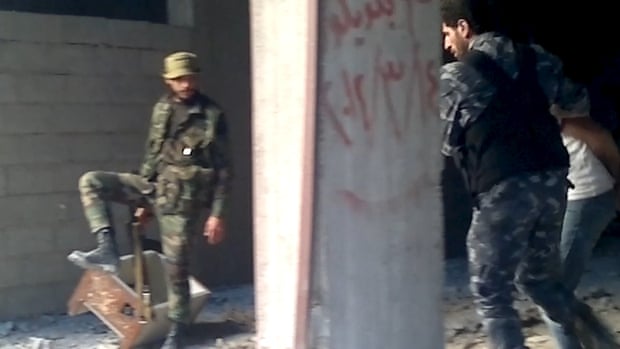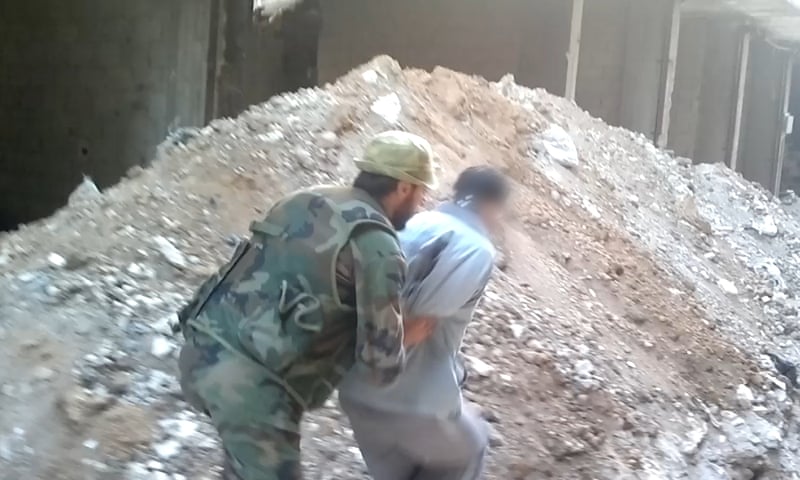A Syrian journalist recounted details of the Tadamon massacre in the southern suburb of Damascus that took place on April 16, 2013, in which 41 civilians were killed, including children and women, before a shocking report by the Guardian days ago.
Matar Ismail, who was living in southern Damascus at the time, confirmed that the leaked footage depicts the killing of 41 victims, but the total of the clips is 27 clips, which monitor 288 victims who were martyred in 2013. They were executed in the same way and the same place, and then they were buried and burned in this hole.
The Istanbul-based journalist told Zaman al-Wasl that the massacre took place in the southeastern part of the Tadamon neighborhood in south Damascus, two-thirds of which was controlled by the regime, while the opposition controlled the rest, during the early years of the Syrian revolution.
Most of the victims of the Al-Tadamon neighborhood massacre were civilians dressed in neat clothes, which indicates that their arrest was not from a long time ago and did not show any signs of torture or change the condition of those arrested for a long time, and most of the time they were arrested on the same day or the previous day They were led to this pit and were filtered within half an hour and subsequently burned.
Ismail confirmed that the 41 victims of the massacre were mostly residents of the "Al-Tadamon" neighborhood or from the surrounding areas, who were arrested from the "Yarmouk" refugee camp checkpoint, which separated it from the "Al-Midan" neighborhood.
Ismail pointed out that the regime forces committed other massacres, no less bloody than the "Solidarity" massacre in the last quarter of 2012.

The journalist has videos of executions and liquidations against civilians, some of whom were killed in their homes after the rebels withdrew from the "Tadamon" neighborhood.
At that time - as the source recounts - he entered the "Al-Tadamon" neighborhood and filmed a report broadcast on the "Al-Jazeera" channel, during which, he says, he pictures a cemetery of victims who were executed in the same way, and the people buried them in a small garden inside the neighborhood.
After the rebels took control of the camp in December 2012, residents were forced to go out by the hundreds a day towards Damascus to secure their needs after a partial siege on the area, and then return before sunset, with the checkpoint closed in the evening by the regime, and some of them escaped from the siege without returning.
The atmosphere of the exit process, which was dangerous and terrifying, and the source lived through for the first and last time, was interspersed with cases of sniping for passers-by who were forced to head from “Al Rijah” Square towards the main “Yarmouk” Street to reach the checkpoint, a distance of about 400-600 meters, in which centimeter of which can be That anyone be killed.
The area was exposed to regime snipers, who were often amused by targeting civilians, causing a number of casualties.
After the people arrived at the checkpoint, they are subjected to a careful inspection process that intensified over time, and there dozens and perhaps hundreds of civilians disappeared without knowing their fate, except for the lucky ones - and there the criminal "Amjad Al-Youssef" chose his random list of victims, to kill them in a barbaric and inhuman manner.

Genocide
Ismail pointed out that the area surrounding the regime forces’ checkpoint is like a black hole, as it extends from the area of the hall buildings, the “Al-Majid” mosque, the “Al-Bashir Mosque”, all the way to the automatic bakery between “Al-Zahira and Al-Tadamon.” This place was a hotbed for gangs and armed men affiliated with a number of security and military agencies, the most important of which are the National Defense Forces and Military Intelligence Branch 227.
Al-Tadamon neighborhood turned into a military barracks at the time and was divided into 15 military areas (ghettos) and inside it a secret prison. Each leader of a group of regime mercenaries acted with absolute comfort in the area he controlled, and in addition to fighting against the Syrian opposition forces, they were practicing as stated in the "Guardian" report. 4 types of violence: the systematic mass killing, the administration of prisons and detention centers, sexual assaults, and economic exploitation, and they were carrying out arrests on a daily basis without reasons, but it was part of the regime's extermination strategy of the other side.
The Syrian war led to the loss of at least 500,000 lives and displaced more than 13,2 million people. It was began in 2011 after the Assad regime brutally cracked down on peaceful pro-democracy protests.
Faris Al-Rifai
















Comments About This Article
Please fill the fields below.